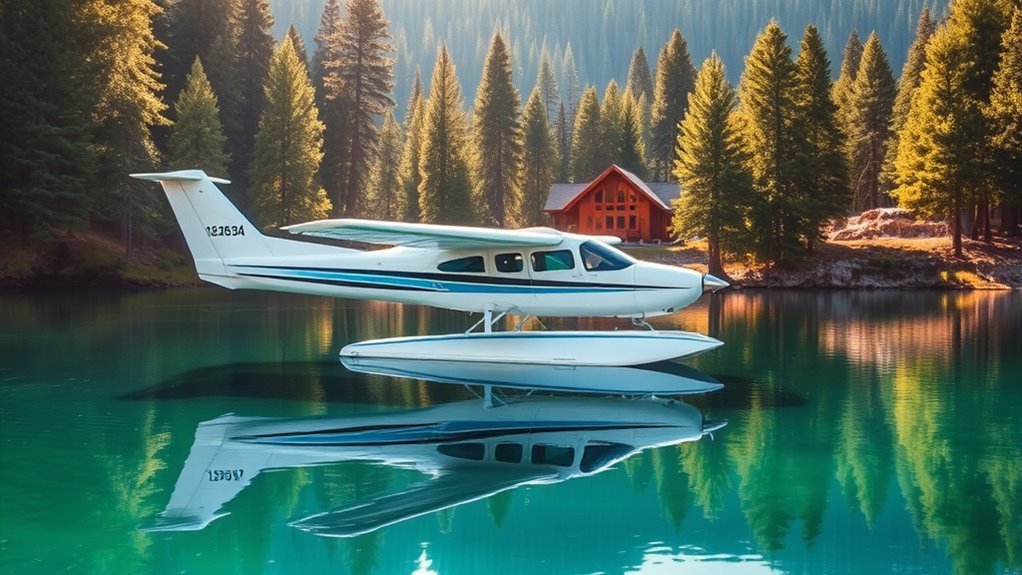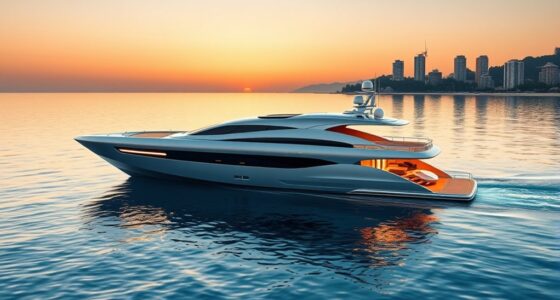Chartering electric seaplanes for your remote eco lodge offers a sustainable, efficient way to access secluded destinations while reducing your environmental impact. These aircraft provide quieter, emission-free flights that preserve local wildlife and fragile ecosystems. With advanced battery technology and charging infrastructure, you can enhance guest experiences and boost your eco-friendly reputation. Although there are challenges like limited range and recharge times, ongoing innovations promise to make electric seaplanes an increasingly viable option. Discover how to start integrating them today.
Key Takeaways
- Partner with specialized eco-friendly aviation providers offering electric seaplane charters to ensure sustainable travel.
- Assess and develop necessary infrastructure, such as docking and charging stations, for seamless electric seaplane operations.
- Plan routes carefully around charging station locations and weather conditions to optimize flight schedules and safety.
- Market the eco lodge’s commitment to sustainability by highlighting electric seaplane access as a unique, environmentally responsible feature.
- Collaborate with local communities and conservation initiatives to enhance cultural preservation and ecological benefits.
The Rise of Sustainable Travel and Remote Eco Lodges
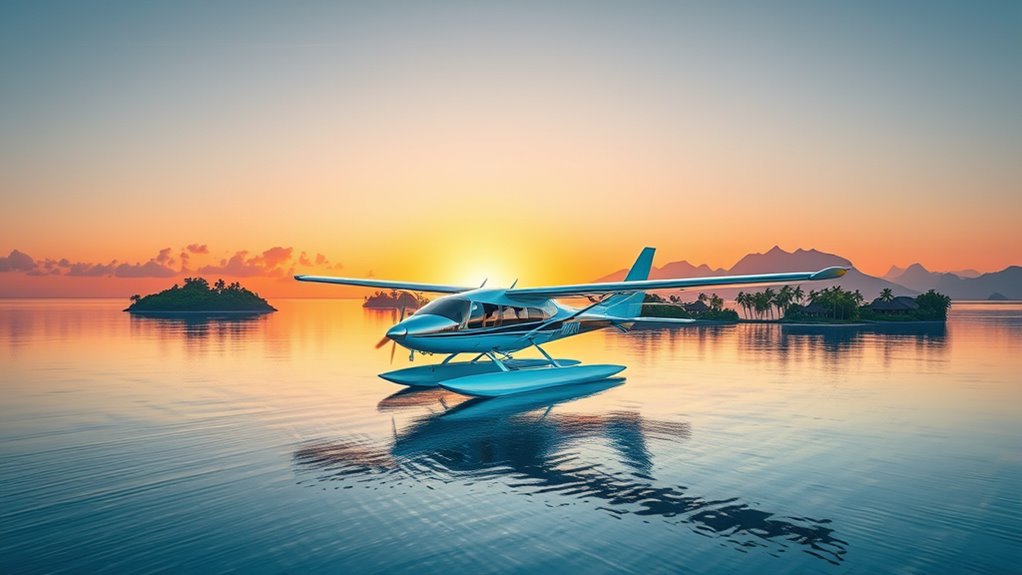
As travelers seek more environmentally friendly options, sustainable travel and remote eco lodges are gaining popularity. These lodges often rely on eco-conscious transportation methods, including seaplanes, which require expert marine navigation skills to operate safely in delicate ecosystems. When chartering electric seaplanes, you’ll appreciate how their quiet, emission-free flights reduce environmental impact. Proper seaplane maintenance is crucial to ensure safety and efficiency, especially in remote locations where access is limited. By choosing electric seaplanes, you support eco-friendly travel practices that align with the goals of remote eco lodges. This trend allows you to enjoy pristine environments while minimizing your carbon footprint, making your adventure both sustainable and memorable. Incorporating sustainable aviation practices into your travel plans further enhances the environmental benefits of your journey.
How Electric Seaplanes Revolutionize Access to Secluded Destinations
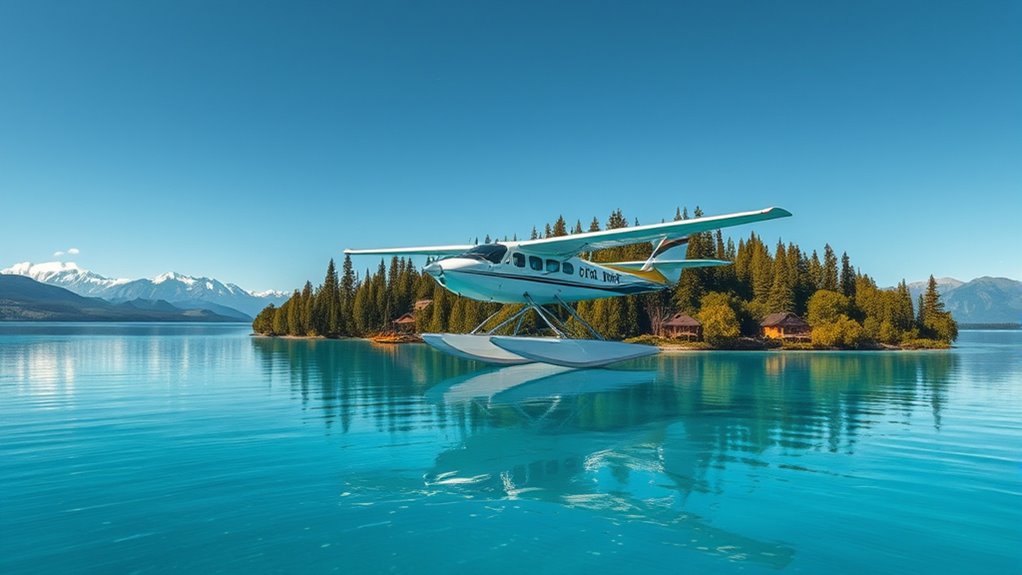
Electric seaplanes are transforming how you reach remote and untouched destinations by offering faster, quieter, and more eco-friendly flights. Their silent operation minimizes disturbance to local wildlife, enhancing underwater exploration opportunities. This means you can access secluded spots without alarming marine life, allowing you to observe marine biodiversity more naturally. Electric seaplanes considerably reduce travel time to remote eco lodges, making spontaneous underwater exploration easier. Their ability to land on water expands access to islands and coastal regions previously difficult to reach. By removing noise pollution and emissions, electric seaplanes help preserve the serenity of secluded environments, ensuring your journey doesn’t harm fragile ecosystems. Additionally, advances in projector technology contribute to creating immersive experiences during your stay, whether through high-resolution screens or ambient lighting. This revolution in transportation opens new horizons for eco-conscious travelers enthusiastic to explore pristine underwater worlds.
Environmental Benefits of Using Electric Aircraft in Eco Tourism
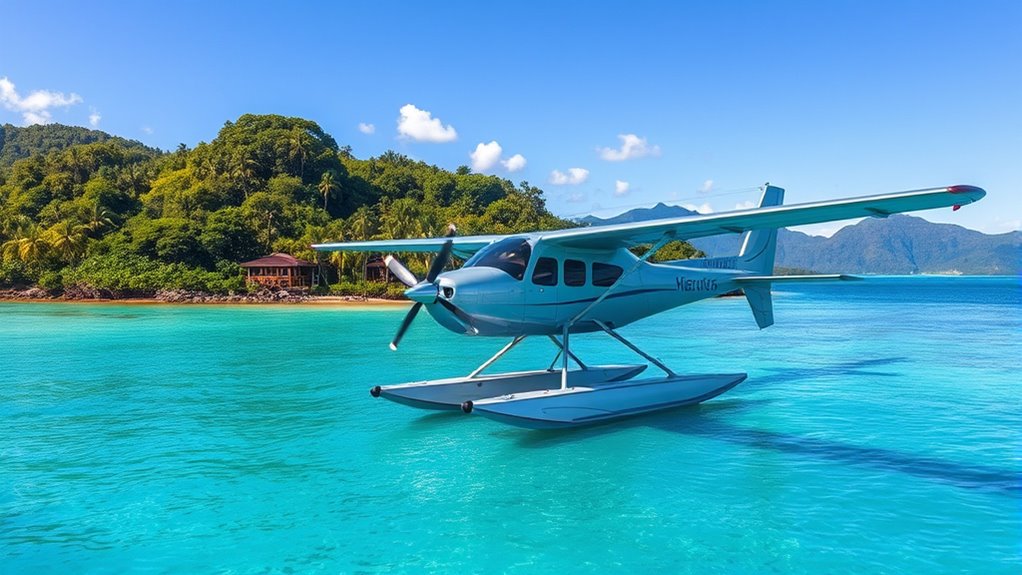
Using electric aircraft in eco tourism markedly reduces environmental impact compared to traditional fossil fuel-powered planes. You’ll help protect marine conservation by decreasing emissions that harm aquatic ecosystems. Electric engines produce zero tailpipe emissions, meaning less air pollution and a smaller carbon footprint. This reduction contributes directly to healthier oceans and wildlife habitats. Additionally, electric seaplanes markedly cut noise pollution, which benefits marine life and nearby communities. Lower noise levels minimize disturbance to animals and reduce stress on marine species, supporting conservation efforts. By choosing electric aircraft, you promote sustainable tourism that respects nature’s balance. This shift not only preserves pristine environments but also enhances your eco lodge’s reputation for responsible travel. Ultimately, electric seaplanes make eco tourism more sustainable and environmentally friendly. Moreover, implementing sound recording techniques can help capture the natural ambiance of remote locations, further emphasizing the eco-friendly focus of your lodge.
Key Technologies Powering Electric Seaplane Operations
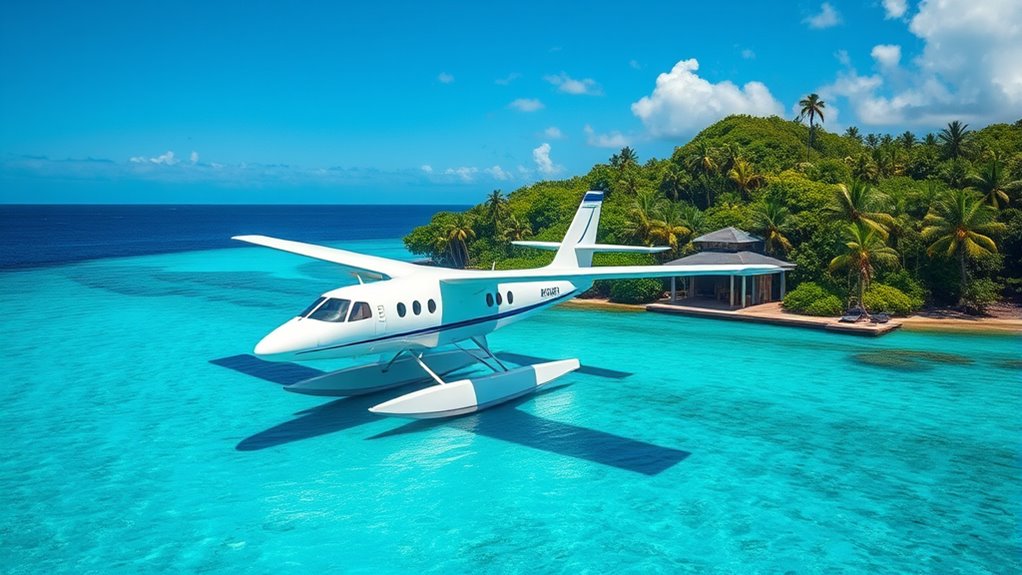
Advancements in key technologies enable electric seaplanes to operate efficiently and reliably in eco tourism. Modern battery systems provide high energy density, allowing for longer flights essential for remote access and cargo delivery. Power management systems optimize energy use, ensuring maximum range and safety. Electric motors deliver instant torque, improving performance during takeoff on water and aerial firefighting tasks. Lightweight materials reduce overall weight, boosting efficiency. For aerial firefighting, rapid deployment and precise maneuverability are critical, which these technologies support. Cargo delivery benefits from reliable, quiet operations that minimize disturbance to wildlife. Additionally, integrating advanced energy management systems enhances overall operational efficiency and safety. Overall, these innovations make electric seaplanes versatile tools for eco lodges, expanding capabilities while maintaining sustainability and safety standards.
Comparing Electric Seaplanes to Traditional Aircraft and Boats
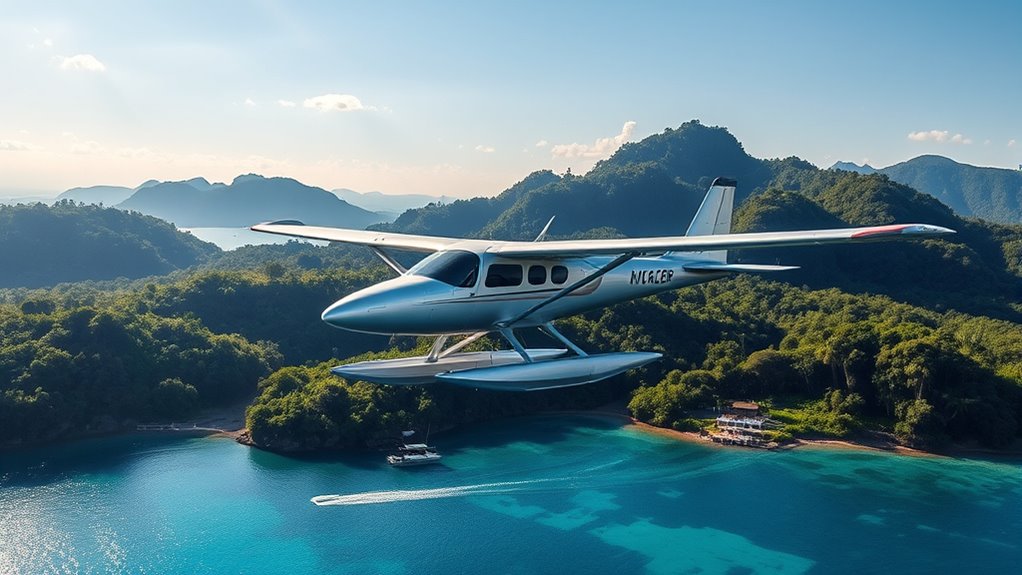
How do electric seaplanes measure up against traditional aircraft and boats? They excel in efficiency, reducing emissions and noise, making them more eco-friendly. Electric seaplanes offer simpler seaplane maintenance, lowering operational costs. When compared to boats, they provide faster travel and better marine navigation capabilities. Traditional aircraft, however, often have longer ranges and established infrastructure. Here’s a quick comparison:
| Feature | Electric Seaplanes | Traditional Aircraft & Boats |
|---|---|---|
| Marine Navigation | Advanced GPS systems | Established protocols |
| Maintenance | Simpler, fewer parts | More complex, more parts |
| Emissions | Zero emissions | Higher emissions |
| Speed & Range | Moderate | Longer range, faster |
This makes electric seaplanes a compelling choice for eco lodges seeking sustainable, low-cost operation. Sustainable aviation advancements could further enhance their viability for remote operations.
Case Studies: Eco Lodges Embracing Electric Seaplane Chartering
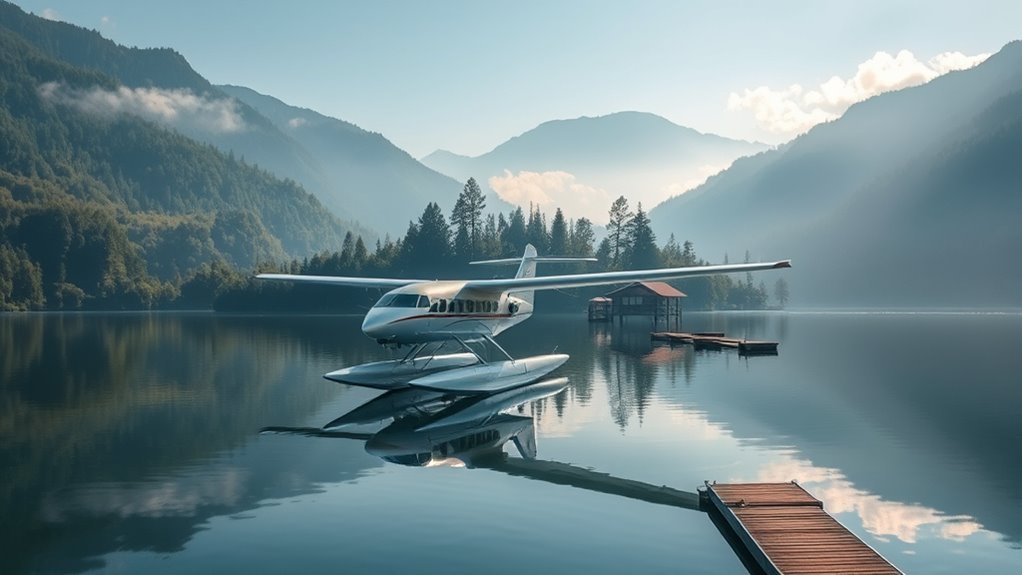
Eco lodges around the world are increasingly turning to electric seaplane chartering to enhance their sustainability and guest experience. These lodges showcase how electrification supports wildlife conservation by reducing noise pollution and emissions that disturb local ecosystems. For example, in remote rainforest regions, lodges have adopted electric seaplanes to minimize their environmental footprint and protect sensitive wildlife habitats. Additionally, many lodges focus on cultural preservation, using electric seaplane access to connect guests with indigenous communities respectfully and sustainably. By integrating electric seaplanes, these lodges foster a deeper appreciation for local traditions while reducing impact on the environment. Incorporating spiritual practices such as meditation and mindfulness can further enhance guests’ connection to nature and promote a sense of harmony with the environment. This approach demonstrates how innovative transportation can align with conservation goals and cultural integrity, setting a new standard for eco-friendly tourism in remote destinations.
Challenges and Limitations of Electric Seaplane Transportation
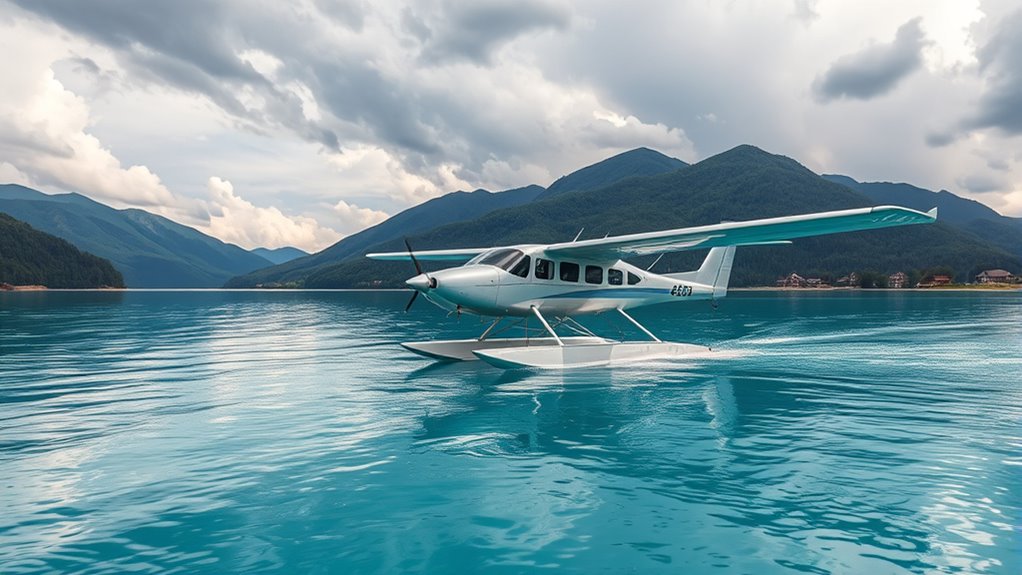
Electric seaplanes face significant hurdles that could limit their practicality. You might encounter issues like limited flight range, battery recharge times, and weather conditions that affect safety and reliability. Addressing these challenges is essential for broader adoption of electric seaplane travel. Additionally, integrating essential oils for respiratory health could potentially improve pilot and passenger comfort during flights, especially in challenging weather conditions.
Limited Flight Range
Have you ever wondered why electric seaplanes can’t fly as far as traditional ones? The main reason is limited battery capacity, which directly impacts flight duration. Unlike fuel tanks, batteries store less energy relative to weight, restricting how long you can stay airborne. This means your electric seaplane’s range is shorter, making long-distance travel more challenging. You might find yourself needing to stop more often for recharging or planning routes carefully around available charging points. While advancements are ongoing, the current battery technology still limits the distance an electric seaplane can cover in a single flight. As a result, these aircraft are better suited for short hops or routes where quick turnaround times are possible, rather than extended journeys across vast distances. AI discoveries have the potential to revolutionize energy storage and propulsion systems in the future.
Battery Recharge Challenges
While limited battery capacity restricts how far electric seaplanes can fly, recharging them presents its own set of challenges. Battery efficiency varies depending on the technology used, affecting how quickly and effectively you can recharge between flights. Developing reliable recharge infrastructure in remote eco lodge locations is difficult, as it requires installing specialized charging stations that can handle high power demands. Without sufficient infrastructure, downtime increases, reducing operational flexibility. Additionally, long recharge times can delay schedules and limit daily flight cycles. To address these issues, you need to invest in advanced battery technology and build strategic charging hubs. Improving battery efficiency and expanding recharge infrastructure are essential steps to making electric seaplane transportation viable for remote destinations. Furthermore, understanding sound healing science can inspire innovative approaches to stress reduction for staff and travelers during transit and stay.
Weather Dependency Issues
Weather conditions substantially impact the operation of electric seaplanes, often causing delays or cancellations. Weather unpredictability makes planning flights difficult, especially since sudden storms, fog, or high winds can ground aircraft at critical moments. Seasonal restrictions also come into play, as certain times of year bring more adverse weather, limiting flying windows. These limitations can disrupt scheduled charters, leading to unpredictable schedules and potential delays for your eco lodge guests. While electric seaplanes excel in efficiency and low emissions, their reliance on stable weather conditions remains a challenge. You must carefully monitor weather forecasts and plan flights accordingly, understanding that in some cases, weather unpredictability can restrict access altogether, impacting reliability and operational flexibility. Incorporating weather dependency considerations into your planning is essential to ensure smooth operations and guest satisfaction.
Future Trends in Eco-Friendly Aviation and Remote Hospitality
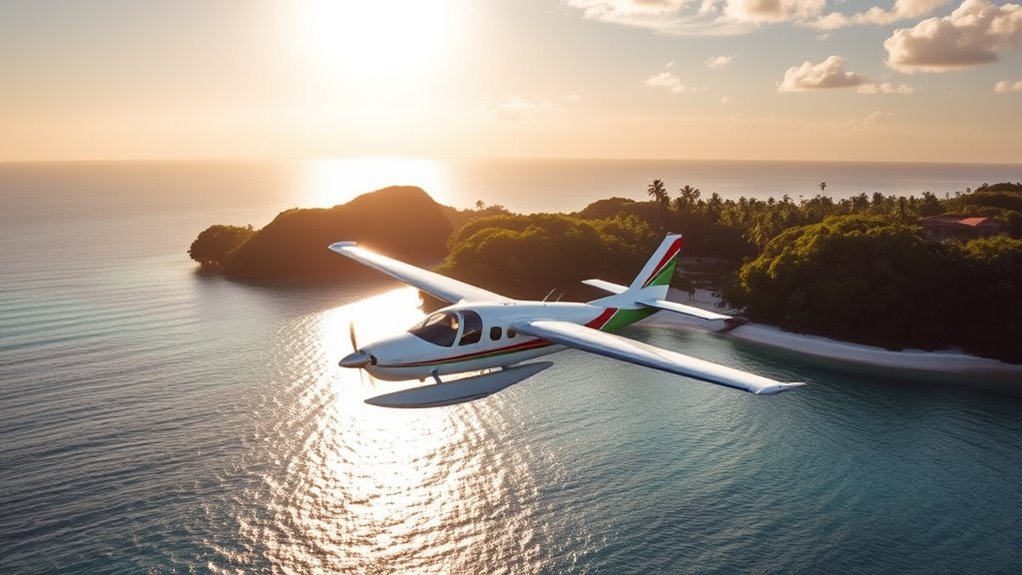
Green Flight Technologies is paving the way for cleaner aviation, making electric seaplanes more viable and accessible. As sustainable tourism grows, remote destinations will become easier to reach with minimal environmental impact. You’ll see eco-friendly travel options expand, transforming remote hospitality into a more sustainable industry.
Green Flight Technologies
As advancements in electric propulsion accelerate, Green Flight Technologies is shaping the future of eco-friendly aviation and remote hospitality. Innovative designs are integrating electric seaplanes into urban infrastructure, making access to remote eco lodges more seamless. These technologies reduce emissions and noise, aligning with global sustainability goals. However, integrating electric aircraft requires steering through evolving airline regulations that address safety, certification, and airspace management. You’ll see airports and urban centers adapting infrastructure to support these aircraft, from charging stations to modified docking facilities. This progress not only benefits the environment but also enhances your travel experience by offering quieter, cleaner flights. As green flight tech advances, it’s clear that electric seaplanes will play a vital role in connecting remote lodges with modern, eco-conscious travel.
Sustainable Tourism Growth
The adoption of electric seaplanes is opening new horizons for sustainable tourism, making eco-friendly travel more accessible and appealing. As more remote eco lodges embrace electric seaplanes, you’ll see a positive impact on marine biodiversity by reducing emissions and pollution. This shift encourages conservation efforts and minimizes disturbance to fragile ecosystems. Additionally, electric seaplane maintenance is simpler and quieter, helping preserve local habitats and marine life. Future trends include:
- Increased connectivity to remote destinations
- Enhanced eco-conscious travel experiences
- Lower operational costs for lodges
- Improved preservation of marine biodiversity
- Growth in eco-tourism markets worldwide
These advancements promote sustainable tourism growth, aligning travel with environmental stewardship and ensuring that remote natural wonders remain pristine for generations to come.
Steps for Eco Lodges to Incorporate Electric Seaplane Services
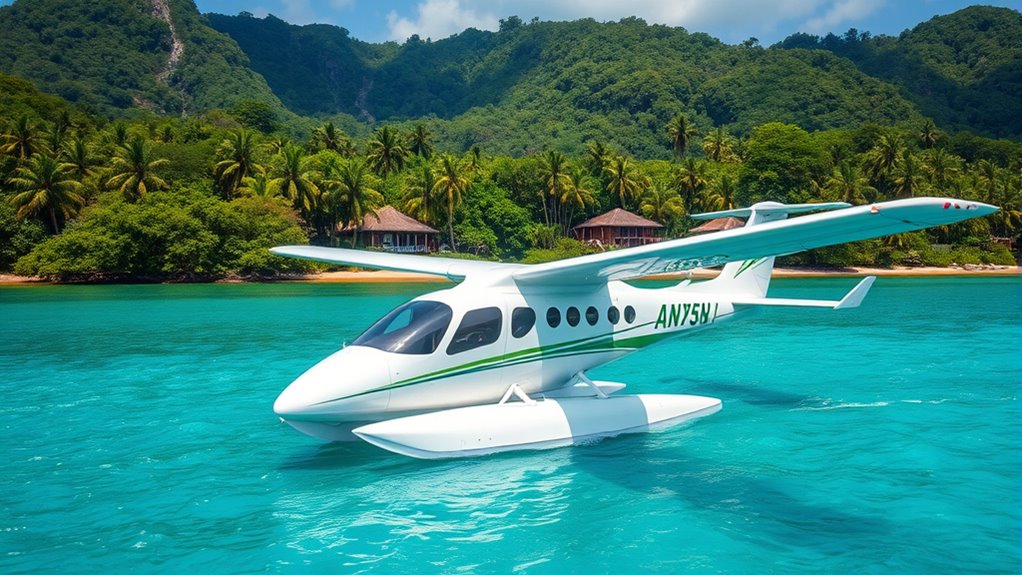
Integrating electric seaplanes into your eco lodge’s offerings can considerably enhance your sustainability efforts and attract environmentally conscious travelers. To do this, start by collaborating with providers experienced in eco-friendly aviation, ensuring they prioritize wildlife conservation and cultural preservation. Next, assess your location’s infrastructure needs, such as docking facilities and charging stations, to support electric seaplane operations. Engage with local communities to promote cultural preservation and ensure their involvement in planning. Educate staff about the environmental benefits and safety protocols of electric seaplanes to deliver a seamless guest experience. Finally, promote your new service through targeted marketing, emphasizing your commitment to reducing carbon footprints while protecting wildlife and local cultures. These steps will position your lodge as a leader in sustainable, culturally respectful tourism.
Frequently Asked Questions
What Are the Safety Standards Specific to Electric Seaplane Operations?
You need to prioritize safety standards for electric seaplane operations, focusing on battery safety and pilot training. Make certain batteries are regularly inspected, properly maintained, and have fire suppression systems in place. Pilots should receive specialized training on handling electrical systems, emergency procedures, and battery management. By adhering to these safety protocols, you can minimize risks and ensure secure, smooth flights for your remote eco lodge guests.
How Do Electric Seaplanes Handle Adverse Weather Conditions?
Think of electric seaplanes as agile dolphins, gracefully steering turbulent waters. They’re designed with weather resilience in mind, allowing them to handle adverse conditions better than traditional aircraft. Advanced sensors and real-time weather data help pilots adjust routes swiftly. In emergencies, clear procedures and automated systems enhance safety, ensuring you stay secure even when the skies turn hostile. You can trust these eco-friendly vessels to weather the storm with confidence.
What Is the Typical Cost Comparison Between Electric and Traditional Seaplane Charters?
You’ll find that electric seaplane charters often offer significant cost savings compared to traditional options, mainly due to lower fuel and maintenance expenses. Plus, they provide notable environmental benefits by reducing emissions. While initial costs might be higher, the long-term savings and eco-friendly advantages make electric seaplanes an attractive choice for sustainable travel. Overall, they balance affordability with a positive impact on the environment.
Are There Any Regulatory Hurdles for Deploying Electric Seaplanes in Remote Areas?
Imagine a world where eco-friendly travel soars effortlessly. You’ll face regulatory hurdles like government approvals, which are essential but can be complex, especially in remote areas. You also need to contemplate the environmental impact, ensuring electric seaplanes meet safety standards. While regulations are evolving, proactive engagement with authorities and demonstrating sustainability benefits can smooth the path for deploying these innovative aircraft in untouched landscapes.
How Is Charging Infrastructure Managed at Eco Lodge Remote Locations?
You manage charging infrastructure at remote eco lodges by leveraging renewable energy sources like solar or wind power. Installing dedicated charging stations guarantees your electric seaplanes stay ready, reducing reliance on external power grids. You can incorporate energy storage systems to balance supply and demand, making the process sustainable and efficient. This approach not only supports eco-friendly operations but also enhances your lodge’s commitment to environmental stewardship.
Conclusion
As you explore eco lodges embracing electric seaplanes, it’s almost like nature and innovation found each other by chance, creating a seamless, greener adventure. With advancements in technology and growing eco-consciousness, you might just find yourself arriving at your remote getaway in a way that feels both exciting and responsible. Who knew that a simple flight could align so perfectly with your love for nature and sustainable travel? It’s a coincidence worth celebrating.

